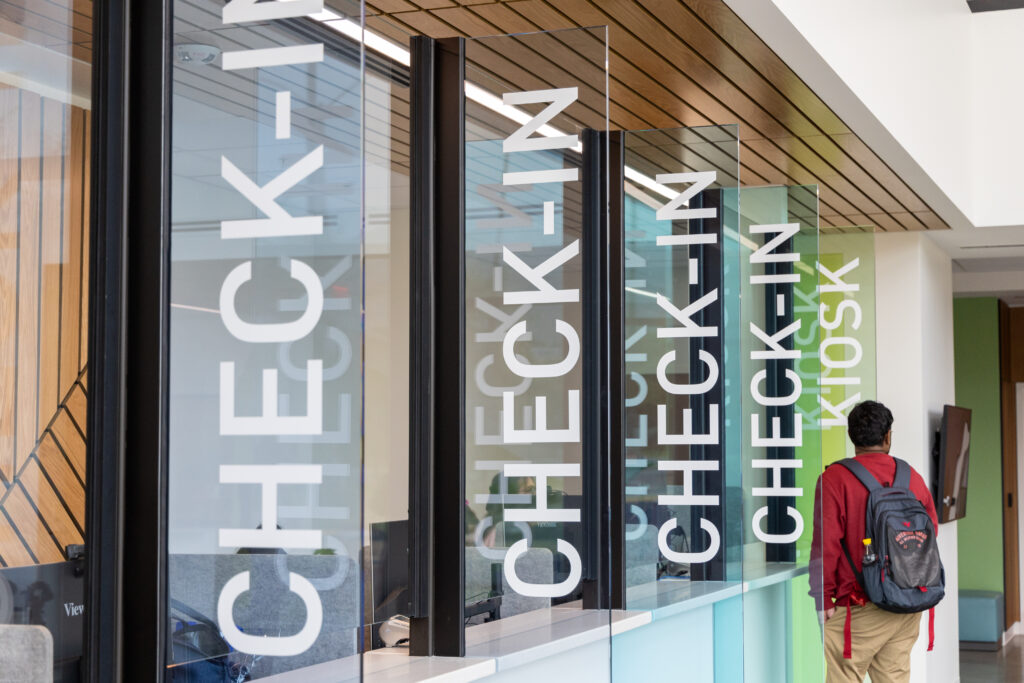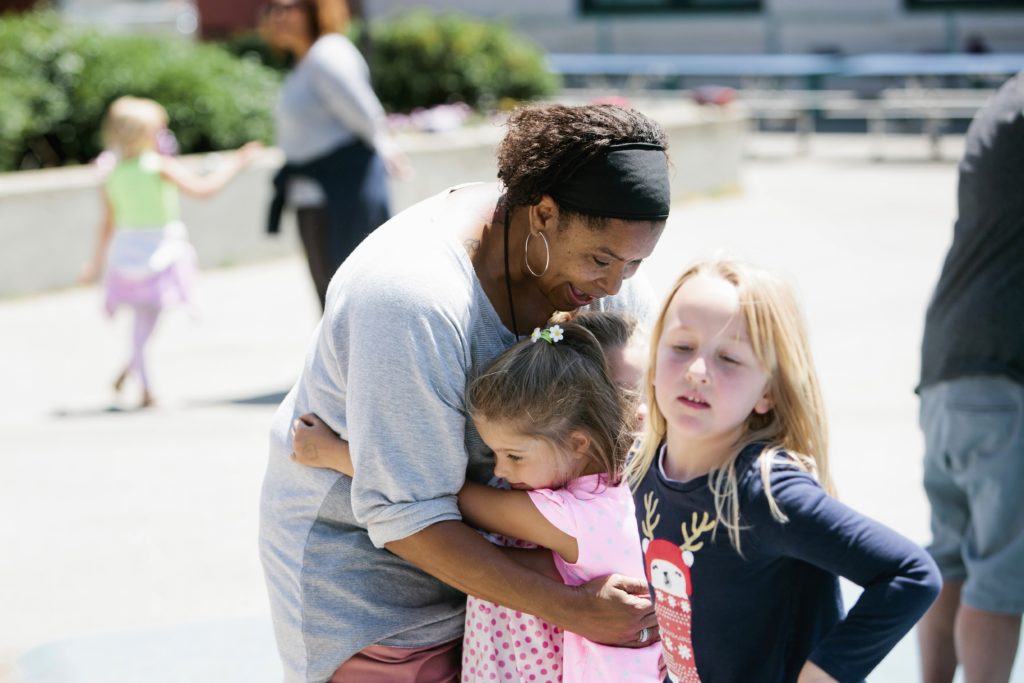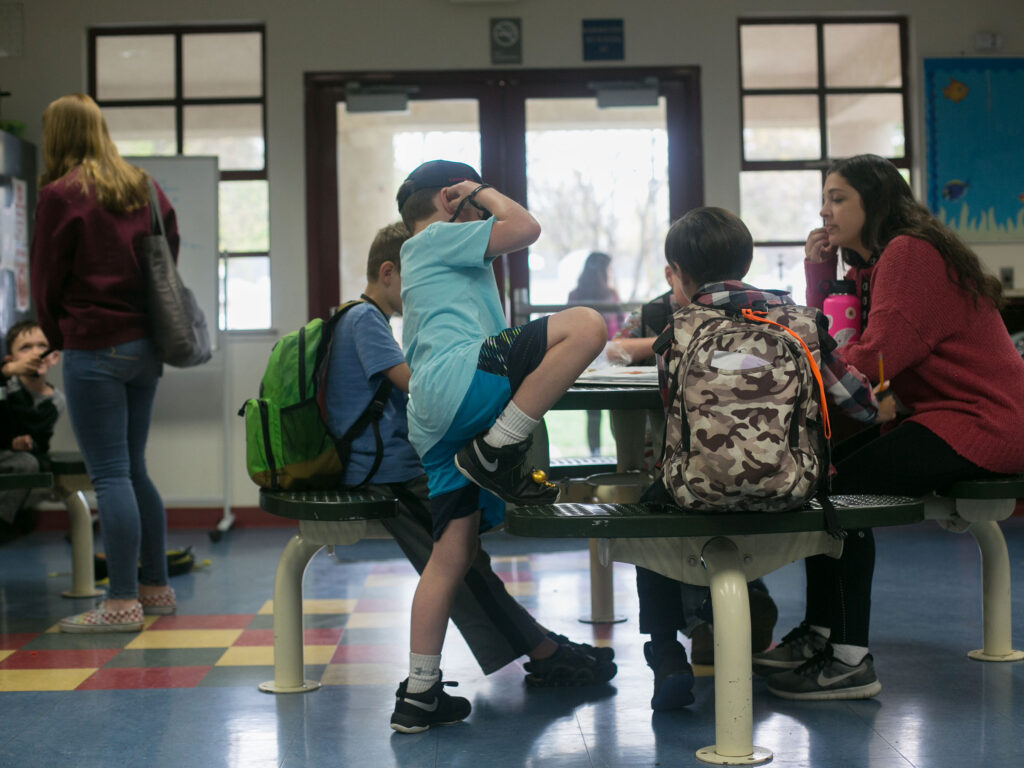
The lobby at UC Riverside’s new Student Health Center.
Credit: Stan Lim / UC Riverside
A newly built $36 million student health clinic at UC Riverside aims to provide a wide array of medical and mental health services in an attractive building that showcases views of nearby mountains. The two-story Student Health and Counseling Center includes a food pantry, a pharmacy, an outdoor balcony for meditation and waiting rooms that look like hip hotel lobbies.
And beyond serving Riverside students, it may become a national model of how campuses are investing more resources to keep their students physically and emotionally well in the post-pandemic era, experts say.
The 40,000-square-foot clinic will provide “one-stop shopping for wellness” that integrates physical and mental health services, said Denise Woods, UC Riverside’s associate vice chancellor of health, well-being and safety. During a recent tour, she said she expects that the building will make it easier for a student to tap into multiple types of services.
The new UC facility replaces a 60-year-old building that is half its size and was built when the student population, now about 27,000, was much smaller. Paid for by UC bonds and other funds, the clinic centralizes services that had been scattered around campus and moves them closer to dormitories for students’ convenience.

Credit: Stan Lim / UC Riverside
The new Student Health Center at UC Riverside.
Nadia Colón, a fourth-year psychology and law and society double major who is a student senator, said many students have been looking forward to the new building, which opened last month. “I think it will be perfect for students who need medical or counseling help,” she said. The old, smaller building has some good services, but “the new building, from what I have seen, is updated and has more resources.”
The medical health clinic and pharmacy are on the first floor along with a satellite food pantry for students who need food or household supplies to get through the week. Mental health counseling rooms are on the second floor, with extra soundproofing so passersby cannot hear therapy sessions.
Helps with recruiting
Experts say the new health center is an example of how colleges and universities are emphasizing students’ medical and psychological wellness much more than in the past, particularly after the challenges posed by the pandemic and the emergence from it. In the long run, they say, such attention pays off for the schools, helping to recruit new students and improving graduation rates and alumni relations.
“For a long time, we’ve known that physical and mental health and well-being are an important part of academic success, retention and graduation. It’s been shown that when students are physically and emotionally well, they perform better,” said physician Michael Huey, former interim chief executive officer of the American College Health Association and former executive director of Emory University’s health and counseling services.
More universities are renovating or replacing old health facilities and grouping services under one roof, he said. For students seeking medical or counseling assistance for the first time without their parents’ guidance, encountering a “modern, spacious, clean and professional-appearing center” helps them get past initial fears, Huey added. And ensuring privacy in counseling rooms helps to ease the stigma some young people might feel about reaching out for emotional help, he said.
New health centers can also bolster new enrollment, according to Richard Shadick, who is a board member of the Association for University and College Counseling Center Directors and director of the counseling center at Pace University in New York City. “I think having a new building that addresses the needs of students, the physical and psychological needs of students, is a great idea. More and more families are looking at the wellness services provided by schools when making a decision about where the students go to college. It’s become rather common for that being a selling point for a college or university,” he said.

Credit: Stan Lim / UC Riverside
The pharmacy at the Student Health and Counseling Center.
National surveys by the American College Health Association show a significant drop this past spring in the rate of undergraduates who rated their health as very good or excellent compared with 2020: 47% compared with 55%. However, it shows that the most common health ailments are not life-threatening at their age, such as allergies, back pain, sinus infections and colds.
On the psychological side, more students are coming to college already having experience with mental health counseling or medication. Research by the Center for Collegiate Mental Health, which is located at Penn State, showed that about 60% of students who use college counseling services had been in prior mental health treatment, compared with 48% about a decade ago. Social anxiety among students is on the rise, fueled by social media and concerns about coming back to in-person classes after isolation during the pandemic, according to the center.

Credit: Larry Gordon / EdSource
Dr. Kenneth Han, UC Riverside’s chief medical officer in the new clinic.
At UC Riverside, the new center’s layout placing counseling on a separate floor provides privacy, but the easy proximity to the medical floor also can help physicians and counselors to work closely together and with patients if need be, said Kenneth Han, UC Riverside’s chief medical officer.
“It’s not just about a specific ailment. It’s so much more than that for (a student) to be successful. How are things going in with your classes? With your friends? With your professors? I can see you for your diabetes, your cough, your cold. And we will talk about all those things,” he said.
Last year, about 1,840 students a month came for medical visits and about 590 for counseling and psychological care, the campus reports.
The center handles mainly routine illnesses and injuries like flu, urinary tract infections, stomach pain and sprains and offers vaccinations and birth control. It sends students to local hospitals for emergencies and surgeries.

Credit: Stan Lim / UC Riverside
The Student Health and Counseling Center has 25 exam rooms, more than twice that of the old building.
For example, the center’s doctors will not reset bones and will stitch wounds only if away from the face or hands, officials said. It is open weekday daytime hours, although a nursing phone line is available around the clock, seven days a week, and students may be referred to off-campus urgent care centers on nights and weekends.
Fourth-year student Allison Escobar, a psychology major from Redwood City, said she thinks the new building will attract more students. Recently she worked there as part of a team preparing the center for its opening. It is a big improvement over the old one, which she said “had a lot of things wrong with it.” Here, she said, students especially appreciate the improved and soundproofed counseling rooms. “Students care about their privacy during what they are going through. A lot of consideration for privacy is a huge thing,” she said.
Counselors respond to mental health emergencies
Set to launch within months, a new emergency response team of mental health professionals — rather than campus police — will be first responders to most mental health emergencies such as a suicide threat or depression. In response to systemwide UC policies enacted two years ago, all UC campuses have formed or are starting similar teams.

Credit: Larry Gordon/EdSource
The van of the new crisis response team at UC Riverside.
That is now the preferred alternative to dispatching uniformed police in patrol cars whose presence sometimes escalates a situation, although police are available to counter any violence, officials say. The Riverside campus experiences about four such emergency episodes a month on average.
The new emergency intervention team will have offices in the health center, and its blue van is parked just outside, painted with a rainbow logo declaring “UCR Health, Well-Being & Safety, Supporting Student Success Holistically.”
“We want the right people to address the right issues,” Han said. “If there is an underlying mental health issue, we don’t necessarily need to have security get involved.”
Bringing in the outdoors
The clinic was designed by the HGA architectural firm, which has several offices around California, and was built by Turner Construction. Kevin Day, the project’s design principal architect at HGA, said it was important to provide views of the Box Springs Mountain Reserve, a large park next to campus, through the lobby’s glass walls and big windows as well as to have an outdoor courtyard and balcony with shade. Appointment windows on both floors look like contemporary theater box offices, and the interiors are painted in cool pastel shades.
Connecting the clinic to the natural landscape “becomes a part of the healing process. It is really about creating a welcoming environment,” Day said. Knowing that coming to a medical appointment can be stressful, his team’s goal was to design a building that would help “lower the blood pressure.”
The building takes into account the recent pandemic. The 28 counseling rooms are much larger than usual to provide safe distances between therapist and patient. Several of the 25 urgent care and primary care exam rooms have special ventilation systems to limit the spread of air-borne illnesses.

Credit: Stan Lim / UC Riverside
A Student Health and Counseling Center exam room.
The soundproofing for counseling rooms is a switch from the old building, where therapists sometimes had to use noise machines to block conversations from the public. All those rooms have windows, for a brighter atmosphere. Plus, the center is developing a mobile check-in system so students who do not want to wait in a public lobby can go directly to their appointments when notified via text.
Online counseling became more popular during the pandemic, and that will still be offered as an option. However, many colleges and universities across the nation reported overall declines in demand for all counseling services during the pandemic even as mental health problems increased. Numbers have rebounded at many schools but not to the pre-pandemic level. UC Riverside hopes to build up those visit numbers as students get familiar with the new building.
Unless they opt out and use family or other coverage, UC Riverside students pay about $2,100 a year for campus health insurance as part of their registration fees and receive most medical services without any additional costs. All students, regardless of insurance status, can get free, unlimited counseling sessions, although most usually need only four to six visits; that is funded through the mandatory $410 annual student services fee.







